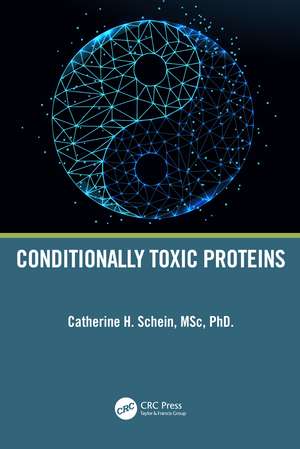Conditionally Toxic Proteins
Autor Catherine H. Scheinen Limba Engleză Hardback – 17 oct 2023
Key Features:
- Shows why gluten proteins are different from all others and how this can account for symptoms throughout the body in those with celiac disease
- Illustrates that "multiple allergy syndrome" is not only real and related to similar allergens in extremely different plants
- Discusses the difficulties in using human proteins and cytokines as therapeutics
- Presents examples of how protein aggregates are vital to many physiological processes but also characterize renal and neurological syndromes
- Shows examples of protein toxins that have medical and industrial uses
Almeida, P. Proteins: Concepts in Biochemistry (ISBN 978-0-8153-4502-2)
Williamson, M. How Proteins Work (ISBN 978-0-8153-4446-9)
Lopata, A. L., ed. Food Allergy: Molecular and Clinical Practice (ISBN 978-0-3677-8199-6)
Wegrzyn, R. D. & A. S. Rudolph, eds. Alzheimer’s Disease: Targets of New Clinical Diagnostic and Therapeutic Strategies (ISBN 978-1-4398-2708-6)
Preț: 696.40 lei
Preț vechi: 819.29 lei
-15% Nou
Puncte Express: 1045
Preț estimativ în valută:
133.27€ • 138.63$ • 110.02£
133.27€ • 138.63$ • 110.02£
Carte tipărită la comandă
Livrare economică 14-28 aprilie
Preluare comenzi: 021 569.72.76
Specificații
ISBN-13: 9781032366937
ISBN-10: 1032366931
Pagini: 176
Ilustrații: 2 Tables, black and white; 5 Line drawings, color; 14 Line drawings, black and white; 15 Halftones, color; 14 Halftones, black and white; 20 Illustrations, color; 28 Illustrations, black and white
Dimensiuni: 152 x 229 x 11 mm
Greutate: 0.4 kg
Ediția:1
Editura: CRC Press
Colecția CRC Press
ISBN-10: 1032366931
Pagini: 176
Ilustrații: 2 Tables, black and white; 5 Line drawings, color; 14 Line drawings, black and white; 15 Halftones, color; 14 Halftones, black and white; 20 Illustrations, color; 28 Illustrations, black and white
Dimensiuni: 152 x 229 x 11 mm
Greutate: 0.4 kg
Ediția:1
Editura: CRC Press
Colecția CRC Press
Public țintă
Adult education and ProfessionalCuprins
Introduction. The yin and yang of conditionally toxic proteins. Ch. 1 How to make a toxin. Ch. 2 Blood and gas. Introduction to Ch. 3 and 4 Intolerance and Elimination Diets. Ch. 3 Minding the Ps and Qs of Gluten. Ch. 4 The Peanut Gallery and Other Allergen Families. Ch. 5 The two faces of interferon. Ch. 6 Storming cytokines in infections and cancers. Ch. 7 Aggregation and Solubility: making milk from cheese. Ch. 8 Converting bacterial toxins to human therapeutics.
Notă biografică
Dr. Catherine H. Schein earned a BA from the University of Pennsylvania in Biochemistry, a MSc from the Massachusetts Institute of Technology in Biochemical Engineering and a PhD from the Swiss Federal Institute of Technology (Zürich) in Technical Microbiology, with thesis projects on hemoglobin and the extracellular proteins of pathogenic Streptococci. Her interest in conditionally toxic proteins began while in a blood lab at a major hospital, which introduced her to blood groupings, leukemias and other blood diseases. Watching a young cousin go into anaphylactic shock after eating a nut (he survived but does his own cooking) led to her work on determining why seemingly innocuous proteins in food and pollens can cause extremely negative reactions in certain people. She produced pharmaceutical proteins, interferons (IFN) and other cytokines, at the industrial scale, for treating infections and cancers. During this work, she developed methods to prevent the aggregation of proteins, which have been used to produce thousands of other proteins for research and medical use. After transitioning to academic research, she studied interactions of IFN with ribonucleases and other cellular proteins, inhibitors of viral proteins and bacterial virulence factors, and distinguishing properties of allergenic proteins. She also studied inhibitors of aggregation of human proteins that form plaques in the brain characteristic of Alzheimer and other neurodegenerative diseases.
This book reflects a central principle common to all these projects: that valuable pharmaceutical and food proteins can also be toxins, depending on context.
This book reflects a central principle common to all these projects: that valuable pharmaceutical and food proteins can also be toxins, depending on context.
Descriere
Human health depends upon access to high-quality proteins for our diet and pharmaceutical use. This book deals with the nature of toxicity as it applies to proteins in food and drugs.
